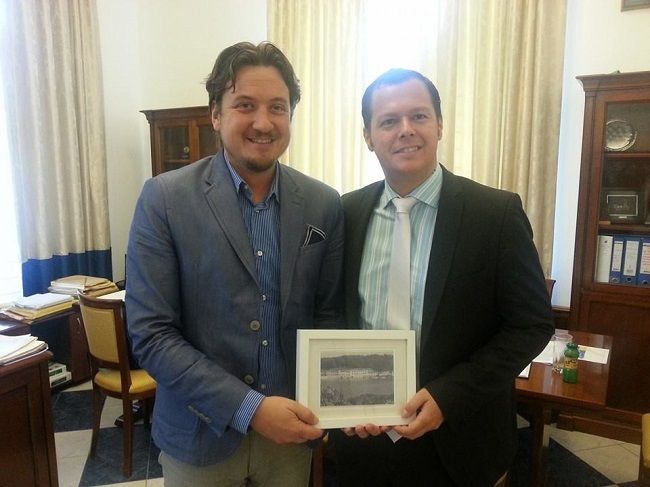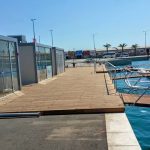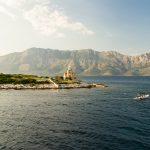A high profile sexy project showing the modern cool Croatia. Could it be the poster child of the country’s break with its corrupt past?
Sitting in a press conference at Pescara Airport following the arrival of the maiden seaplane flight from downtown Split on February 5, 2016, I was struck by a wave of conflicting emotions.
The day had been planned to be a quiet one at home catching up on outstanding articles for clients, but an invitation the night before to go for coffee in Italy on the maiden flight from European Coastal Airlines to Pescara proved hard to resist, and it was a pleasure to witness a little more ECA history, as their 15-year battle with bureaucracy continues.
Although my Italian is limited, I could sense the genuine excitement from local officials and journalists at the press conference. Pescara, not known as a major transport hub in Italy, was now connected directly to Spalato, the capital of Dalmatia, with other routes promised. It was not only a chance for Italians to visit Croatia, but also for Croats to explore the Abruzzo region, particularly this time of year, offering as it does the best local quality skiing to Croatia.
“How much interest is there in reglious tourism to Medjugorje, for example?” I asked. “ECA has the flight to Split with connecting transfer to Medjugorje. And what about religious tourism to other destinations, such as Jelsa on Hvar? There is a UNESCO-protected Easter Procession dating back 500 years.”
As a colleague took copious notes, the deputy mayor spent several minutes answering my question, much of which was sadly lost on me due to the paucity of my language skills, but the general message was positive, and this Jelsa procession sounded very interesting indeed. So interesting, I found out later, that the airline is prepared to put on direct flights to Jelsa from Italy for Easter if someone can organise the package.

Two small places, Pescara and Jelsa, neither of which would qualify ordinarily as a prime destination, but here a bond was found. Religious processions aside, Jelsa is the gateway to Croatia’s premier island of Hvar, and the Italian market is an important one, and one suddenly much more accessible.
I have been following the seaplane story for years, and first wrote about it in 2011 (a version of that article survives online). It has been a fascinating story (but not quite as entertaining as the unpublished story I am sure…), and one which finally came to life on the morning of August 27, 2014, with the first scheduled seaplane flight in modern European aviation history from Resnik near Split Airport to my home town of Hvar.
It was almost nine months to the day since the first meeting between ECA and Jelsa authorities, a meeting I was delighted to attend, as ECA Sales and Marketing manager Jan Albers presented Jelsa Mayor Niksa Peronja with a framed photograph of a seaplane in his town more than 80 years before.
Nine months may seem an incredibly long time in any normal country to sort out a seaplane route, but this is Croatian bureaucracy on acid, and not only did Jelsa become the first destination for ECA (and it was not even considered as one of the original destinations), but in the process of getting established, all the lessons were learned – for ECA and local authorities – on mistakes to be avoided in future. Jelsa learned, Jelsa opened, Jelsa thrived. In nine months.
And the point of this editorial is this – if Jelsa can do it and make the mistakes so that others have to, why is it taking so long for others to follow suit?
Of course there are those who are opposed to seaplanes. I don’t think I am giving away many state secrets when I say that some officials might be willing to help if their palms are greased. Others worry about the noise, and another complaint is it is too exclusive and not for locals, an argument I find hard to fathom. Apart from the fact that ECA has done great commuity work where I live (ask the schoolkids in Jelsa school, for example) and discounted tickets have been made available, Croatia is a tourism country, and just because I can’t afford to stay in the Meridien Lav or drink Zlatan Otok Grand Cru, it does not mean these things should not be available for those want them and are willing to pay.
Opposition to seaplanes is fine. If a community does not want them, say so. End of story.
But if they do want them, say yes, and work to get to a transparent solution. There was such a negative reaction to the concept of seaplanes in downtown Split, after Mayor Baldasar first gave a location permit, then took it back, then announced it had nothing to do with him. A solution was found, and now you can fly to Hvar, Korcula, Lastovo, Losinj, Pula, Dubrovnik, Ancona and Pesara from downtown Split, all in an hour or less.
12 months a year.
With more destinations on the way.
Croatia has a new government and a bright new dawn. A non-partisan Prime Minister called PowerPoint Tim, who comes from Canada, a country very familiar with seaplanes in Vancouver. He is pro-business and enterprise, and perhaps the best way he can show that with concrete results is to support a very high-profile foreign investment tourism project, which has the potential to not only create 400 permanent local jobs, but also transform quality tourism in Croatia.
From my association with the seaplanes project over the years, the support of the previous government was limited, and before we get political, so too was it with the government before that.
We have a bright new dawn, a time for new policy, a time to sweep away the cobwebs of the past. Why not work hard with the seaplane operators to have downtown locations also in Dubrovnik, Sibenik, Zadar and Rijeka, connect island such as Brac, Vis and others further north, give destinations the opportunity to establish connections like the religious one between Pescara and Jelsa? As ECA CEO Klaus Dieter Martin told me in an interview before the flight to Pescara, he is ready to bring year-round connections to Dubrovnik from Bari, Brindisi, Ancona and Pescara, if he gets a location in Gruz harbour. Split has proved that seaplanes can operate in the Croatian reality in busy harbours, and Dubrovnik is looking to extend its season and attract new airlines. Isn’t that a perfect fit?
And if Jelsa can be the pioneer and make everything happen in 9 months, why should it take years for others?
I hear the occasional complaint that at TCN we write too much about seaplanes. Also too much about Hajduk. And some detractors of Total Hvar say I write too much about beer. The reason we write is simple – all three are quality products which should be celebrated more than others.
The seaplanes are modern, sexy, and a high profile foreign investment project of tens of millions of dollars. Investors elsewhere are watching. PowerPoint Tim would do Croatia tourism and the investment climate in Croatia a great service to make its success an early priority to show foreign investors that his government is serious about tourism and attracting investment.









